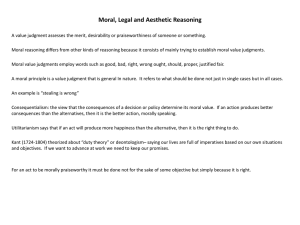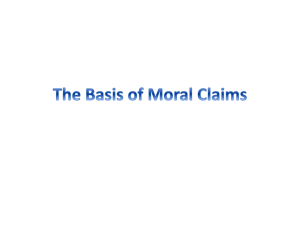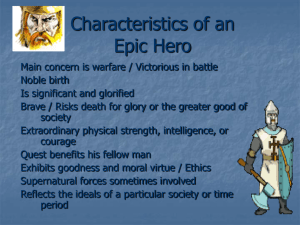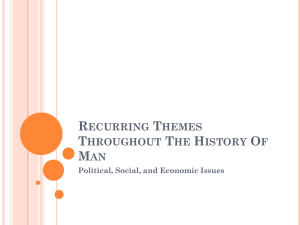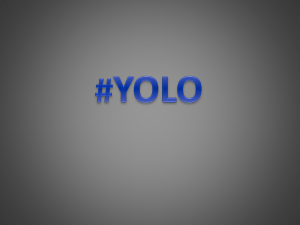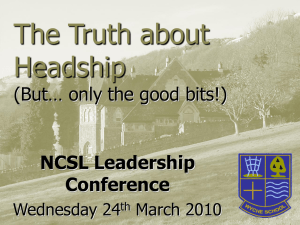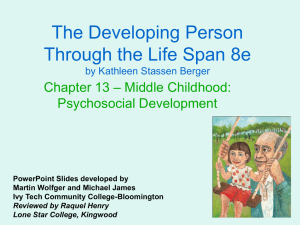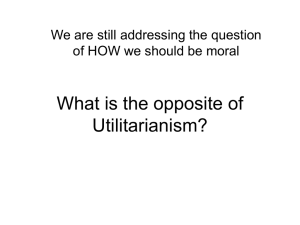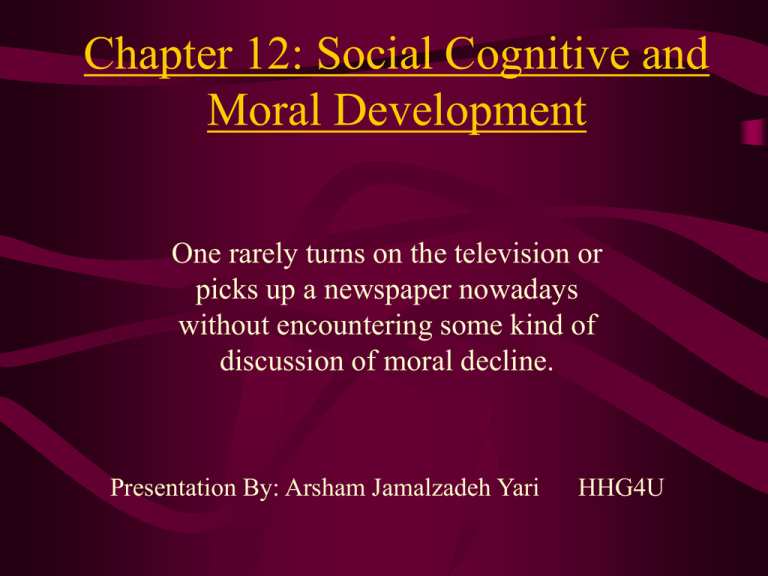
Chapter 12: Social Cognitive and
Moral Development
One rarely turns on the television or
picks up a newspaper nowadays
without encountering some kind of
discussion of moral decline.
Presentation By: Arsham Jamalzadeh Yari
HHG4U
Presentation Time Line
• Introduction
• Development of Social
Cognition
• Figure 12.1 and 12.3
• Moral Development
Introduction To Presentation
• What is social cognition and how can we relate to
it in the 20th century.
• Different developmental feelings and its causes
• Understanding Rules and Intentions
• What is Moral Development, Moral Behavior, and
Moral Reasoning
• Stages of Kohlbergs Moral Development
• Causes and Consequences of Moral Development
Social Cognition
• Social cognition is the understanding and development of our
emotions and how we use them to interact with our environment
• A perfect example of this is when we were all young babies we
were slowly building up on our ability to recognize people
around us and use different expressions to communicate with
them. Now a day’s we actually get to understand them for what
we see and hear and express ourselves in many ways.
• John Flavell believed that social cognition has the same
principles that of general cognition has.
• There are four types of basic infant/children social cognition
developments:
Social Cognition Continued
• Outer-Inner Characteristics: - Younger look for points (I.e color, shape,
texture) while older generations look for a reason or problem.
• Observation-Inference: - Conclusions based on what they see and not
on what they know. Older is different
• Definite-Qualified: - children’s rules are definite while as adolescence
grow their idea of rules change.
• Observer’s-General View: - Decrease if egoism and increase of
relativism.
• Dimensions found to be related to development of thinking. Reasoning
because we as humans, try to conceal everything we can about us so
others may not copy or steal our identity. Therefore if someone is
capable of understanding ones mind than he has a key advantage in
society.
Describing People
• Children in school are found to
have a higher social cognitive rate
than kids who don’t attend school.
(students are given guidelines to
follow their entire school life thus
possibly generating a higher
percentage of SCS.
• Observers believe there is a major
shift from observation to inference
from ages 6-8 (descriptions are
biased on outside interactions).
Usually consists of size, gender,
color, age, and connection with the
child are often what they learn and
enhance first.
• At age 7-8, self-steam stage begins
to develop. Very critical for young
children to develop properly.
Dramatic shift in how they think
about other people and begin to
actually think about the person
with a greater or-deal. Including
personality, faith, future, religion
and much more.
• As children grow up it is thought
to be that they relate one person
with another when looking or
thinking about a specific
characteristic of a person.
Describing People
• Example: Page 340 Andy: In
the example we can see clearly
that his friend is describing this
boy by the name of Andy and is
constantly relating himself to
people and Andy to people.
• Behavioral Comparisons are
when two or more people use
physical features to compare
one or more person’s
personalities. Such that we see
in the example.
• Carl Barenboim 1977-1981 Came
up with the idea of Behaviorism.
• Age group is mostly between 10
to 16 and on.
• Thus Flavells point is confirmed
that indeed the basic principles of
Social Cognitive skills and
General Cognitive skills are
based upon same material
Profiling Peoples Feelings
• Both Cognitive skill and social information are needed to profile
• Pon Harris and de Rosnay 2004: Children build on their
knowledge of emotions over year 1 to adolescence.
• 10-12 Months: Babies already have learned how to differentiate
good and bad facial expressions and tones in a voice.
• Also show social referencing behavior (The ability to alter
behavior based upon an expression).
• 3-4 Years: Knowledge has vastly grown to the point that they
can point out why someone feels the way they do.
• Age 10: Understands emotions and can read some expressions
fully.
Figure 12.1
• The graph is discussing the difference between behavioral comparisons
with organizing relationships. Study 1: Were kids between the age of
10 and 16 that were tested and received higher percentages on their
organizing relationships meaning they understood what they were told
better rather than the second group of children from 6 to 11 that stated
they didn’t have much behavioral comparisons, therefore not being
able to understand emotion in order to change how they are acting.
• Example: If a kid that got into trouble for fighting at age 14 and got
yelled at and could tell that his parents were upset and mad, he would
try to be a better son. However if a kid that did the same thing in
another family but couldn’t tell the difference in emotions his parents
were giving clearly enough than he wouldn’t be able to really change
anything regarding his behavior.
Development: Empathy
• Empathy is the ability to
understand and share feelings of
another. It involves two parts:
First part is understanding the
persons emotional state, and
than matching the emotional
state to himself.
• Most of the time the person that
is empathetic feels all or most of
what the other persons
emotional state is.
• Sympathy is the same however
you don’t match emotions.
• Empathy is learned and developed
before sympathy in children.
• Martin Hoffman: Most informatic
statement suggests that there are
four stages to the analysis of
empathy and sympathy in children.
- Global Empathy: Environment is a
big factor.
- Egocentric Empathy: 12-18
months when the child has a clear
understanding of the difference
between self and others.
- Empathy for others: Middle
Childhood.
- Empathy for another: Inferences
Friendships
• Preschoolers understand friendship as a get together at most.
• Most children believe that friendships are built with personal bonding
time.
• Once elementary school starts the idea of physical bonding turns into
a trust issue for most young kids.
• They understand that friendship has a temporal dimension: Meaning
friends are people who have a history of connection and interaction
unlike before where it was just a one time event.
• Perfect example is on page 344 Figure 12.2 and 12.3
• Around the age of 11-12: they begin to understand and talk about
intimacy in friendships and by mid-adolescence they expect to have a
confident supportive and trusting friend.
Rules and Intentions
• Children must learn the rules of life because it is a major influence on
their emergence of social cognition.
• Conventional Rules: Arbitrary socially defined rules specific to a
particular culture, sub culture or group. I.E: Don’t run in the pool zone,
is used for a specific group of swimmers and there safety.
• At age 7-8 children grasp these concepts better.
• Moral Rules: The universal and obligator y rules reflecting basic
principles that guarantee the rights of each other. Children judge the
breaking of moral rules as far more serious and can lead to
disciplinary.
Moral Development Outline
• What is Moral Development and
its Dimensions.
• Moral Emotions
• Moral Behavior
• Moral Reasoning
• Kohlbergs Stages of Moral
Development
• Description of Stages
• Figure 12.2 on page 351
• Age and Moral Reasoning
• Moral Reasoning across Culture
• Causes and Consequences
• Alternative views
Moral Development
• Moral Development is the
process of learning to
distinguish between right or
wrong according to culture
values.
• It is explained with the terms
of psychoanalytic, learning and
cognitive developmental
theories.
• Dimensions include:
Emotions, Behavior,
Reasoning.
Moral Emotions:
• Moral Emotions are based upon the Psychoanalytic theory which emphasizes
emotions in explaining moral development.
• According to Freud: A child learns moral rules by identifying with the same
sex parent (mom-daughter, son-dad) during the phallic stage. Their super ego
is formed during this stage and it contains two segments: Ego Model and the
conscience. The Conscience tells you what’s right or wrong and what you
shouldn’t do. While the ego model is a list of what's good and you should do.
• Eriksson believes that children also learn moral rules through parents. Pride is
just as important as moral development as guilt and shame.
• Age 10: Connect shame to moral wrongs
• Age 9-10: Children better understand moral feelings, and make more
behavioral choices based on what they might feel.
• Guilt-behavior connection is based up the temperament in a child.
Moral Behavior
• Skinners operant condition model suggests that
consequences teach children to obey moral rules.
• Adults reward children for morally well
behavior with praise. At the same time they
punish them if they don’t follow orders.
• Bandura states that when a child sees someone
rewarded for positive behavior, he will believe
that he will be rewarded as well if he behaves
the same way. Thus he changes his negative
behavior to positive.
• Also states that children learn a lot about moral
behavior both positive and negative.
Moral Reasoning
• Moral reasoning is the process of making judgments about the rightness
or wrongdoing of certain acts.
• Piaget claimed that the ability to use reasoning about intentions to make
judgments about the moral dimensions of behavior appear to develop
along with concrete operational thinking.
• Moral Realism Stage: The first stage of Piaget’s moral development, in
which children believe that rules are inflexible. *Found mostly in
children younger than eight years old.
• Believed that all rule breakers will be punished.
• After age eight, Piaget proposed that children begin the moral relativism
stage. It is the second stage of the stages of Moral Development in
where the children understand that many rules can be changed through
social agreement.
• 8-12: Know that unless you get caught you can break rules without
punishment. Children older than eight understand the relationship
between punishment and intentions. Piaget believes there is more on
intentions than punishments.
Kohlbergs Stages
• Kohlberg pioneered the practice of assessing moral reasoning by
presenting children with a series of hypothetical dilemmas in story for
each with a high lighted of a specific moral. Look at example on page 350
about Heinz famous dilemma.
• Kohlberg concluded that there was three main levels of moral reasoning
each with two stages. Look at Figure 12.2
• Level 1: Preconventional Morality: The moral judgments are dominated
by consideration of what will be punished and what feels good. Stage one
consists of the punishment and obedience orientation. The child relies on
the physical consequences of action. Stage 2 is the individualism and
exchange where the child begins to do things that are rewarded and not do
things that he will be punished for.
• Level 2: Conventional Morality: Where a persons judgments are
dominated by considering a group value and its flaws. Constructs of stage
3: The mutual interpersonal expectations and the child begins to make
judgments based on intentions as well as behavior.
Kohlberg Continued
• Stage 4: the second stage of conventional morality is where the child
turns to larger social groups for his or her ideal. Also known as the
social system and conscience.
• Children reasoning at this stage focuses on doing their duty, respecting
authority and following laws.
• There is a transition from level two to three: Principled Morality, is the
several changes, more importantly the change in the source of authority.
At first authority has no factor but as you age you begin to understand
its meaning and use thus following the greatest authority. Eventually
personal authority comes into play and you make judgments for
yourself.
• In stage 5: Called the social contract orientation, people begin to show
self chosen principles. The laws are still important but also their own
rules are as well. Stage six is the second level in Level 3: and its just a
further extension with the individualism for the highest level of moral
principles. *Universal ethics.*
Kohlberg Continued.
• Kohlberg argued that this sequence of moral development is both
universal and hierarchically organized just as Piaget thought it would be.
• Age n Moral Reasoning: Kohlbergs own findings confirmed may
researchers. It is that Preconventional moral reasoning (stages 1&2) is
dominant in elementary schools, Stage 2 is still evident in middle school
stages 3 and 4 are in high school. Stages 5 and 6 are really rare.
• John Snarey noted that several things in support of Kohlbergs claim that
the stages are universal. 1-Studies in children constantly increase in
reasoning with age. 2-The few progressing through the stage with few
reversals. 3- Cultures differ in the highest level of reasoning observed.
Causes and Consequences
• MR and CD: The idea is that the grater a child's ability to look at a
sitatuaton from another's person perspective, the more advanced they
are likely to be in moral reasoning. The term role-taking is the ability to
look at another persons situation with different perspectives.
• MR and MB: Level of moral reasoning appears to be positively
correlated with prosocial and negatively related to antisocial behavior.
Schonert Reichl 1999.
• Also the connection between moral reasoning and moral behavior
proposed by Kohlberg is that the higher level of moral reasoning a
young person shows, the stronger the link to behavior.
Alternative Views
• Eisenbergs model: He called hedonistic reasoning a form of prosocial
moral reasoning described by Eisenberg in which the child is concerned
with the consequences rather than moral considerations. Aka Stage 2.
• Needs-oriented Reasoning is also another form of prosocial moral
development in which the child expresses concern rather directly for the
other persons need, even if it conflicts with the child's desires.
• In Adolescence, children say they will do good things because it is
expected of them, a pattern highly similar to stage 3 of Kohlberg.
• In Late adolescence, young people give evidence that they have
developed clear values that guide their prosocial behavior.
• Early Adolescence, hedonistic reasoning has virtually disappeared and
need-oriented reasoning has become dominant form.
• Gilligans Ethic of Caring: He argues that there are at least two disticnt
moral orientations: Justice and caring and each has its own central
injunction; not to treat others unfairly (justice) and not to turn away
from someone in need (caring).
Questions
• If Gilligan was right and adult women typically reason based on
an ethic of caring and men reason based on an ethic of justice
what do you think the implications of a male female relationship
would be?
• Name the Difference in Moral Reasoning and Moral Behavior


